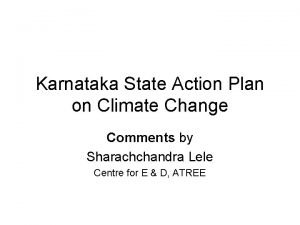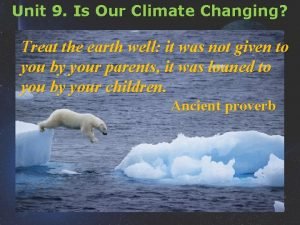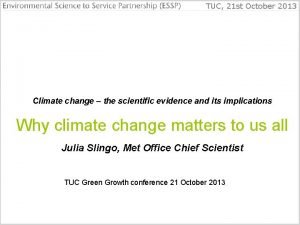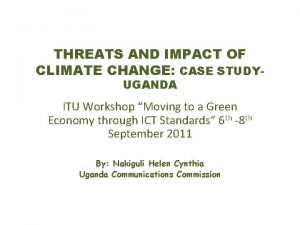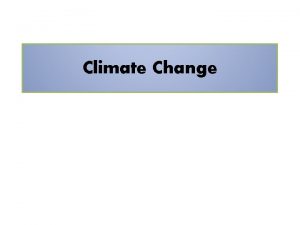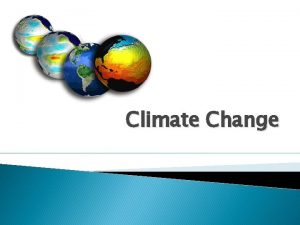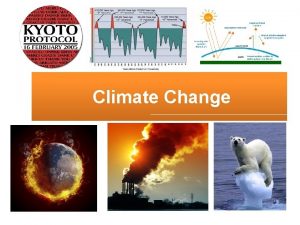Improving the Effectiveness of International Climate Change Governance











- Slides: 11

Improving the Effectiveness of International Climate Change Governance John Drexhage Director, Climate Change & Energy, IISD UNFCC Side Event June 4, 2010

Climate Change Governance • Governance – “the sum of organizations, policy instruments, financing mechanisms, rules, procedures and norms that regulate the processes” of climate change (Najam, Papa and Taiyab, 2006) • Governance involves formal and informal mechanisms, processes and interactions among nations, states/provinces/cities, intergovernmental and nongovernmental organizations, the private sector, networks of specialists.

Climate Change Governance - Actors • Several actors at multilateral level – UNFCCC, other UN bodies, Bretton Woods Institutions, regional development banks, multilateral processes (e. g. , G 8, G 20, MEF), multilateral agreements (e. g. , APP, CSLF, M 2 M). • Increasing involvement of other levels – states/provinces, cities, corporations, private investors, voluntary offset schemes. • Interactions with other international regimes – e. g. , other MEAs, WTO. • Core actor-the driver-is the nation state.

Climate Change Mechanisms and Funds UNFCCC • Existing: CDM, JI, International Emissions Trading; GEF Adaptation Fund; SCCF and LDCF. • New: Copenhagen Accord includes REDD-plus mechanism, Technology Mechanism, Copenhagen Green Climate Fund, High Level Panel for financing, and need for registry of NAMAs. Outside the UNFCCC • e. g. MDBs, UN-REDD, UN High Level Panel on Financing, FCPF • WCI, RGGI, MWGA, EU ETS, EC, Bilateral initiatives • Private Sector Mechanisms: EG, VCS • Other Forums for Discussion: Petersburg Process, MEF, G 8/20, World People’s Conference

Critical Issues in Climate Change Governance • A significant flip is in playt for the UNFCCC; from a top-down approach (Kyoto) to a bottom-up approach. e. g. , Copenhagen Accord emphasizes bottom-up, flexible commitments. • International consequences for non-compliance. • Intended to meet the needs of a diverse group of countries, but what is the price for the environmental and legal integrity of the international agreement? • Implications for: • Rules and regulations for reporting of GHG emissions and scope of reductions • Rules for offsets (international and domestic) • Rules for sinks • MRV • Enhancing cooperation and coordination among the several institutions and bodies. • Creating the linkages with other policy spheres.

Negotiating Forums • Do too many problems beset the UNFCCC? • Too many countries • Too many stakeholders • Too many issues… • Too many AGENDAS… • Alternatives? • Petersburg Process • Would People’s Conference? • Major Economies Forum? • Regional Initiatives?

Critical Issues in Climate Change Governance (cont’d) • Financing is at the heart of the negotiations. • Relationship of traditional funding and the private sector: how to maximize/leverage optimum funding. • Climate change governance is state-centric; yet the private sector and civil society play an increasingly important role in policy making and implementation. • Private sector is expected to channel large amounts of financing and investment if climate change efforts are to be successful.

Financing • How should funds be managed and accounted for under the UNFCCC? • What should be left to other processes? • What decision-making/governance models are needed for both the raising of funds and their distribution and use? • How to expand the limited space for non-national government actors (e. g. , private sector, cities/states, NGOs)? • How can market-based instruments best be designed? • How do we account for the strong linkages between climate change and traditional development activities?

Financing Issues • Green Climate Fund • Separate Entity • How many Boards • Role and Profile of Board(s) • Determination of financing: where does development end and climate change begin? • Energy or mitigation? • Adaptation or natural resource management

The Shift to a Bottom-up Climate Regime • What are the advantages and disadvantages of the shift to a bottom-up regime? • How do we create incentives for broad participation in GHG mitigation? • How do we MRV action; connect commitments to actions? • What is the role of the UNFCCC?

Thank You John Drexhage Director, Climate Change and Energy jdrexhage@iisd. ca
 Climate change 2014 mitigation of climate change
Climate change 2014 mitigation of climate change Climate change paragraph
Climate change paragraph Karnataka state action plan on climate change
Karnataka state action plan on climate change What causes wind to blow brainpop
What causes wind to blow brainpop Climate change meaning and definition
Climate change meaning and definition Chapter 13 atmosphere and climate change section 1
Chapter 13 atmosphere and climate change section 1 Unit 9 climate change
Unit 9 climate change Conclusion of climate change
Conclusion of climate change Youreuropemap.com
Youreuropemap.com Conclusion of climate change
Conclusion of climate change Mathematics of climate change
Mathematics of climate change Globalization ap world history definition
Globalization ap world history definition


